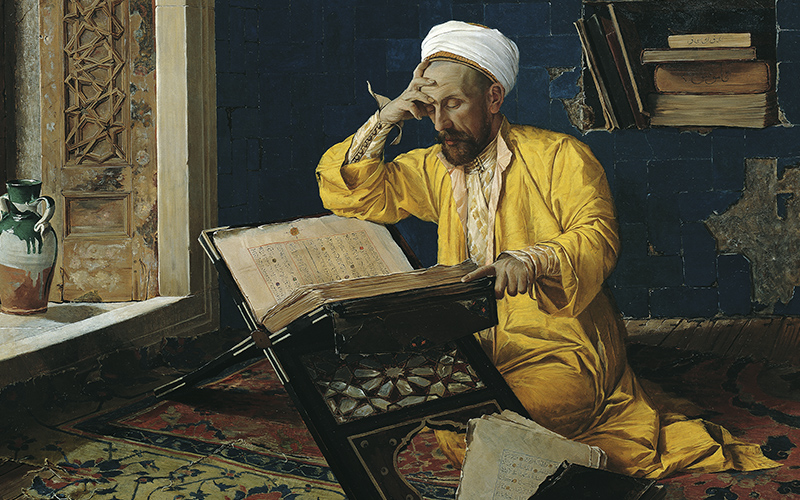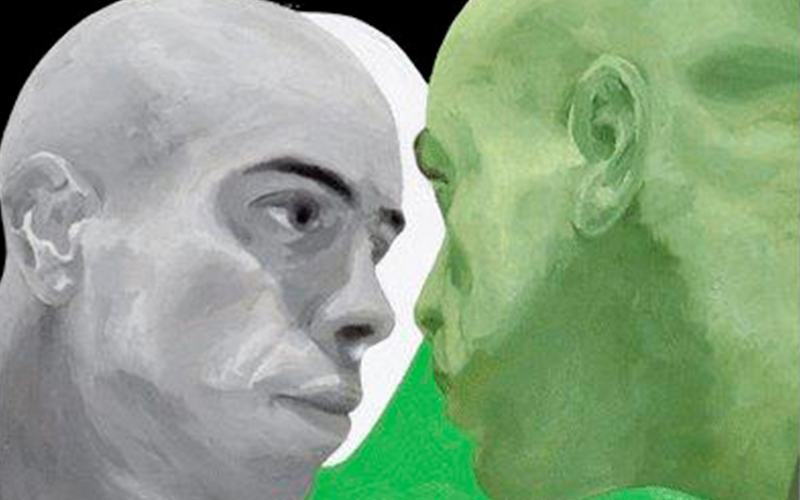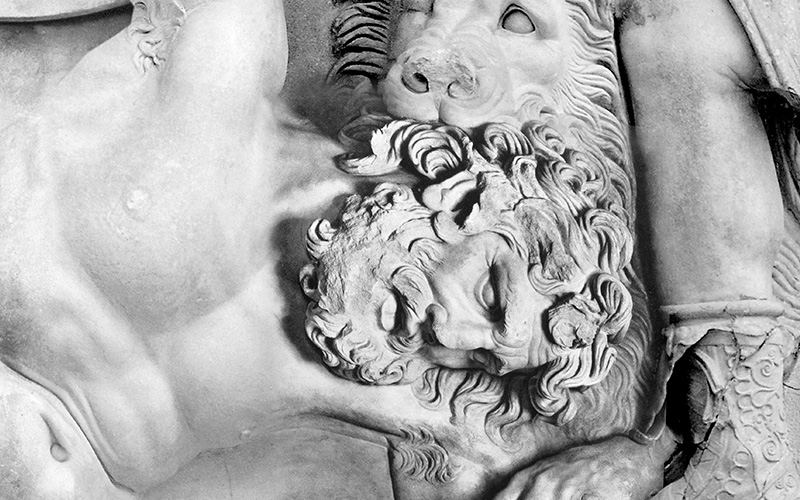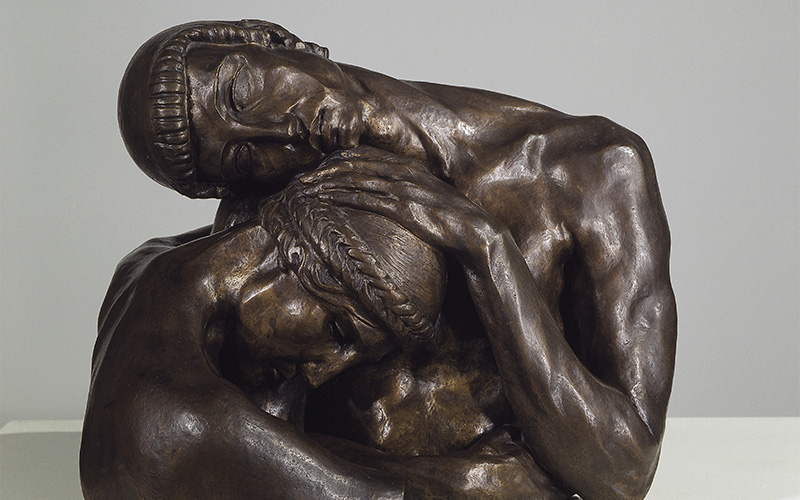
Past exhibitions

Visiting Artwork: Diego Velázquez, Portrait of Philip IV
In this new iteration of the Visiting Artwork initiative, the Calouste Gulbenkian Museum received one of the most significant paintings from the Frick Collection, in New York. It is a portrait of the Spanish monarch Philip IV, by Diego Velázquez.

Treasures from Kings. Masterpieces from the Terra Sancta Museum
This exhibition showed the extraordinary and little-known artistic treasure of the Terra Sancta Museum, amassed thanks to gifts made by several European Catholic monarchs to various churches throughout the territory over the course of 500 years, which is travelling for first time to Portugal.

Floating world: 'ukiyo-e' Japanese prints
Calouste Gulbenkian amassed a remarkable collection of Japanese art. This exhibition explores this aspect of his activity, bringing together a large number of Japanese prints from the 17th to the 19th centuries.

Visiting Artwork: Jean Dunand The ‘Les Cagnas’ Screen
The fourth Visiting Artwork of the Calouste Gulbenkian Museum comes from the Musée des Arts décoratifs, in Paris. This Art Deco work, signed by Jean Dunand, will be exhibited for the first time in the China and Japan gallery alongside the roe deer screen, which belongs to the Gulbenkian Museum collection and was also made by Jean Dunand.

Visiting Artwork: Canopic Jar of Iunefer
The third visiting artwork of the Calouste Gulbenkian Museum comes from the Ny Carlsberg Glyptotek, in Copenhagen. Canopic jars, or viscera jars, were used in Ancient Egypt from the time of the Old Kingdom (2570-2450 B.C.E.) to the Ptolemaic Period (305-30 B.C.E.).

Superstar Pharaohs
'Superstar Pharaohs ' is conceived around the figure of the Pharaoh and the place occupied in our imagination by Ancient Egypt, through 5,000 years of history, from antiquity to the present day. It aims to reflect on the popularity of the historical and sometimes mythical figures of the Pharaohs.

Visiting Artwork: Giulio Romano, Tapestry from the set ‘Children Playing’
The tapestry set Children Playing by Giulio Romano, is composed of four large tapestries and two fragments, belonging to the Gulbenkian Collection. A fragment on loan from the Museo Poldi Pezzoli, in Milan, will be the next Visiting Artwork to be exhibited, reunited for the first time with the rest of the set to which it belongs.

Visiting Artwork: Rembrandt, 'Self-portrait wearing a beret and two chains'
'Self-portrait Wearing a Beret and Two Chains' is an example of one of the Dutch painter’s favourite themes – self-representation under different roles.

Visions of Dante. The Inferno according to Botticelli
On the 700th anniversary of Dante Alighieri's death, we present two exceptional drawings by Sandro Botticelli alluding to the 'Inferno' of the ‘Divine Comedy’, which belong to the Vatican Apostolic Library. The exhibition also includes other works from the Vatican Library, the Gulbenkian Museum and other collections.

René Lalique and the Age of Glass. Art and Industry
The first exhibition that the Foundation dedicates to René Lalique since 1988 revolves around the artist’s relationship with glass, one of the most used materials in his artistic practice. The selection of around 100 objects, from the Founder’s Collection and from other museums and private collections, brings together jewellery, glass objects and design pieces.

Infinite Sculpture. From the Antique Cast to the 3D Scan
This exhibition brings together sculptures by contemporary artists and casts from the collection of the Faculty of Fine Arts of Lisbon, analysing the relevance of the casting technique in current artistic practices and exploring its infinite possibilities.

The Golden Age of French Furniture. From the Workshop to the Palace
In the 18th century, French furniture attained an unprecedented degree of excellency. This exhibition highlights some emblematic items of furniture and aims to show what lies behind the execution of these fantastic pieces.

Artistic Journeys in the Modern Collection
The new exhibition itinerary of the Modern Collection includes 31 artists and 69 pieces, from the early 20th century to the present day, including pieces by Portuguese artists incorporated in 2019, important donations by Jorge Pinheiro, Maria Gabriel and David de Almeida, and newly acquired works by Rosa Carvalho, Ana Léon, Ana Jotta, and new acquisitions of pieces by Mónica de Miranda and Eugénia Mussa.

Manon de Boer. Downtime / Tempo de Respiração
This project by artist Manon de Boer offers a look at experimentation and the creative process. The four films presented focus on informal learning during infancy and childhood and the breathing space required for creativity and imagination.

Art on Display. Formas de expor 1949-69
Marking the 50th anniversary of the Gulbenkian Museum, this exhibition takes as its starting point the display solutions found for the opening of the Museum in 1969. It also recreates different exhibition design ideas created by Franco Albini and Franca Helg, Carlo Scarpa, Lina Bo Bardi, Aldo van Eyck and Alison and Peter Smithson in other countries.

Robin Fior. Call to Action/Abril em Portugal
This exhibition brings together, for the first time, objects designed by Robin Fior in England in the 1960s, and in Portugal, between the 1970s and 1980s. Displaying the British designer’s personal collection, it offers a closer look into one of the protagonists of British and Portuguese design.

Irineu Destourelles. Subtitulizar / Subtitling
Artist Irineu Destourelles developed a project focused on the issues of colonial practices and social and power relations, taking as a starting point his own diaspora.

The Rise of Islamic Art
On the year that marks the 150th anniversary of the birth of Calouste Gulbenkian, this exhibition seeks to understand the growing Orientalism, that the collector and his contemporaries developed, through masterpieces of Islamic art from the Founder's Collection and other important international collections.

Sarah Affonso and Folk Art from the Minho
This exhibition focuses on the relationship between the work of Sarah Affonso and the popular art of the Minho region. Often remembered as the wife of Almada Negreiros, Sarah Affonso was a modernist artist in her own right, with a remarkable career.

Summer Guests. Contemporary Jewellery in Portugal
Contemporary jewellery in Portugal is the theme of this year’s edition of the Summer Guestsinitiative, with curator Cristina Filipe establishing relationships between jewels created in Portugal and works in the Gulbenkian Museum.

Filipa César. Quantum Creole
Filipa César has created both an installation and an essay film that address creolisation beyond language and as a way of thinking about the world. The installation and essay film presented by the artist are the result of a collective research exercise and incorporate various moving image formats, to explore the dynamics of creolisation, in historical and biological contexts.

Francisco Tropa. The Pyrgus from Chaves
Following the discovery of a mysterious object from the Roman period, Francisco Tropa proposes a dialogue between past and present, contemporary sculpture and archaeology.

Yto Barrada. Moi je suis la langue et vous êtes les dents
The starting point for Yto Barrada’s project is the unique and tragic figure of Thérèse Rivière. In the 1930s, the French ethnologist traveled to Algeria, to the Aurès mountains, to study the Berber Chaouis people.

Pose and Variations. Sculpture in Paris in the age of Rodin
Around thirty sculptures from the collections of the Calouste Gulbenkian Museum and the Ny Carlsberg Glyptotek in Copenhagen will feature in the first exhibition to be dedicated to the theme of the pose in nineteenth-century French sculpture.

Art and Architecture between Lisbon and Baghdad
As part of the Calouste Gulbenkian Museum’s programmed cycle, the exhibition Art and Architecture between Lisbon and Baghdaduses the Cultural Week of 1966 and the Iraqi art collection gathered at that time as the central axis for a reflection on the importance of the Foundation’s development support strategy of the time, for a country that was seeking to modernise itself.

Al Cartio and Constance Ruth Howes from A to C
For the Project Space – Modern Collection of the Gulbenkian Museum, Al Cartio and Constance Ruth Howes are presenting a selection of their works on paper in which words and seascapes create rhythmic leaps back and forth across the gallery.

Praneet Soi. Third Factory. From Kashmir to Lisbon, via Caldas
Praneet Soi has been working in the ceramic centre of Caldas da Rainha, making tiles which will act as a screen for his collage-like films.Know more

Summer Guest: Joaquim Sapinho
This exhibition is the second part of an idea that started in 2016 and aims to continue: bringing into the permanent display of each of the collections of the Calouste Gulbenkian Museum the presence and reality of the other. This year, the challenge was proposed to filmmaker Joaquim Sapinho.

Aimée Zito Lema. 13 Shots
The work of Aimée Zito Lema (Amsterdam, 1982) touches on the dynamics between individual and collective memory, with a particular focus on the recording and intergenerational transmission of events, both through material history and through the human body as a mnemonic repository.

Post-Pop. Beyond the commonplace
This exhibition presents, in its entirety, works produced almost exclusively between 1965 and 1975, in Portugal and England. Some of them are united by a witty divergence from the commonplace put forward by Pop Art.

Sara Bichão Find me, I kill you
The exhibition is born of an intense personal experience that led the artist to question herself: as a singular identity, with her own body, and as a part of a whole. Sara Bichão relates the panic she experienced in a volcanic lake when, swimming alone, halfway across the crater, she realised she was right in the middle of it.

The Emperor’s Flowers. From the Bulb to the Carpet
Throughout the 16th century, Europe’s extensive relations with the world reshaped its knowledge of nature. New products and previously unknown plant and animal species were brought to Europe from the West and East Indies. Seeds and bulbs of exotic flowers were brought from the Levant.

Mariana Silva. Camera Trap
The artistic work of Mariana Silva is marked by a strong conceptual component that reflects her preoccupation with questions of culture, museology and sociology in general.

Beyond the Mirror
Beyond the Mirror, a title that deliberately alludes to the world of Alice Liddell, the heroine created by Lewis Carroll (1832-1898), is a thematic exhibition, which takes the mirror as its main focus. The intention is to show the polysemic presence of this object in the iconography of European art, particularly within painting, but also in sculpture, books, photography and film.

Ana Hatherly and the Baroque. In a Garden Made of Ink
This exhibition-essay has only one subject: Ana Hatherly and the Baroque. However, we will not focus solely on the influence of the Baroque on the artist’s work, but on how Ana Hatherly’s research and experimentation enhanced the value of this disparaged historical period and modified our concept of the past – after all, tradition is an unexplored territory of adventure and continual amazement.

Sculpture on Screen. The Very Impress of the Object
This exhibition explores the fascination that classical sculpture has held for large numbers of contemporary filmmakers and artists, a fascination which also reflects an apparent contradiction: why is it that contemporary artists working with moving images are so interested in the absolute immobility embodied in classical sculpture?

Emily Wardill. Matt Black and Rat
Matt Black and Rat presents recent work by artist Emily Wardill (1977, UK), who has lived and worked in Lisbon since 2014. Produced in collaboration with the Bergen Kunsthall, the exhibition presents two new films, a new series of sculptures-reliefs and an original set of rayograms.

Helmut Federle Abstract matter (paintings and ceramics)
The Calouste Gulbenkian Museum is preparing an exhibition on the work and collections of the 17th century Moroccan and Japanese ceramics of the Swiss painter Helmut Federle, which will be placed in dialogue with the Museum’s Islamic art ceramics, both in the space of the Islamic art Hall, at the permanent exhibition, as in the Lower Gallery.

Eid al-Fitr. Breaking the fast
In 2017, the Calouste Gulbenkian Museum presents two installation-interventions in the Gallery of Islamic Art – Founder’s Collection, each based on a celebration of great symbolic significance in the Islamic world.

José de Almada Negreiros: a way of being modern
The exhibition presents a body of work that reflects the complex, experimental, paradoxical and hybrid condition of modernity. Almada’s paintings and drawings are closely linked to the work he did in collaboration with architects, writers, publishers, musicians, set designers and stage directors. This selection also testifies to the importance of film and the persistence of the graphic narrative.

Manuela Marques and Versailles. The hidden face of the sun
The Lower Floor Gallery of the Calouste Gulbenkian Museum hosts the first public exhibition of a group of photographs made by the artist Manuela Marques over several months at Versailles. Wandering around the palace.

Tamás Kaszás. Joy of Surviving
The exhibition brings together a group of works that, departing from an imminent scenario of ecological and economic collapse, gives rise to the creation of a fiction of an alternative future, built on the values of imagination, collaboration, self-sufficiency, and the recovery and reinterpretation of an ancestral popular science.

Noruz, Feasting in Spring
The exhibition “Noruz, Feasting in Spring” is included in the “New Year’s Celebrations: Islamic Art in the Gulbenkian Museum”, a larger initiative that includes another exhibition opening in June.

Portugal em Flagrante
Portugal em Flagrante is a semi-permanent exhibition of the Calouste Gulbenkian Museum’s Modern Collection designed to offer both an introduction to the history of art and culture in Portugal during the twentieth century and a more in-depth resource for students and academics.

António Ole. Luanda, Los Angeles, Lisboa
Retrospective exhibition examines the work of António Ole, who has been a guiding figure for an entire generation of contemporary Angolan artists.

The Shape of Plain
The Shape of Plain examines the impact of history of art on artistic and architectural practices through the work of American art historian, George Kubler.

Lines of Time. The Gulbenkian Collections. Contemporary Paths
From that date, this exhibition takes us back 60 years to 1896 and guides us up to the present day, providing a space for dialogues and links between two collections: the collection acquired by Calouste S. Gulbenkian up to 1955 and the Modern Collection, comprised of works ranging from the 20th century to the current day.

Building Site
Just as the forms of architecture determine the organization of building sites, so technology and economy organize methods of production – with a significant social impact. These conditions constrict and stimulate architectural conception.

I do not evolve, I travel. José Escada Retrospective
The Modern Collection presents the first retrospective exhibition devoted to the painter José Escada (Lisbon, 1934 – 1980). This exhibition shines a spotlight on an artist who produced a highly unique body of work that continuously oscillated from abstraction to figuration, and moved between painting, drawing, collage, cut-out reliefs and illustration, as well as painted and sgraffito murals.

Summer Guests
Summer Guests brings contemporary artists to the Calouste Gulbenkian Museum proposing new exhibition contexts that highlight crosscutting and unexpected relationships, and formal or conceptual proximity of works from different eras.

Kum Kapi. Travelling Carpets
Kum Kapi carpets owe their name to a district of Istanbul where, in the 19th century, various Armenian master carpet makers settled to create their rich knotted carpets of silk, with metal threads, inspired by the classic Persian carpets of the 16th and 17th centuries.

Molière: The Staging of Writing
The Calouste Gulbenkian Museum once again celebrates World Book and Copyright Day by highlighting, this year, the work of one of the greatest playwrights of all time – Jean Baptiste Poquelin (1622-1673), better known by the name Molière.
